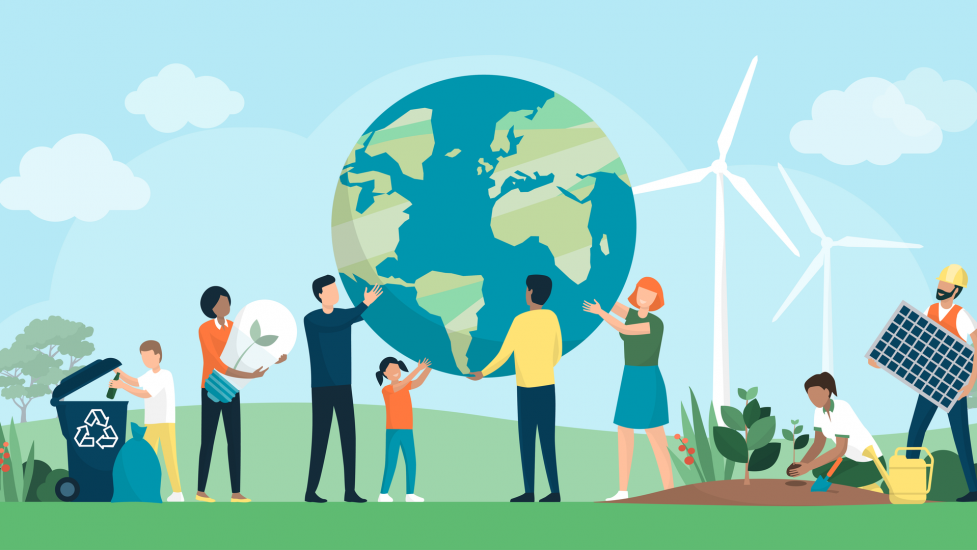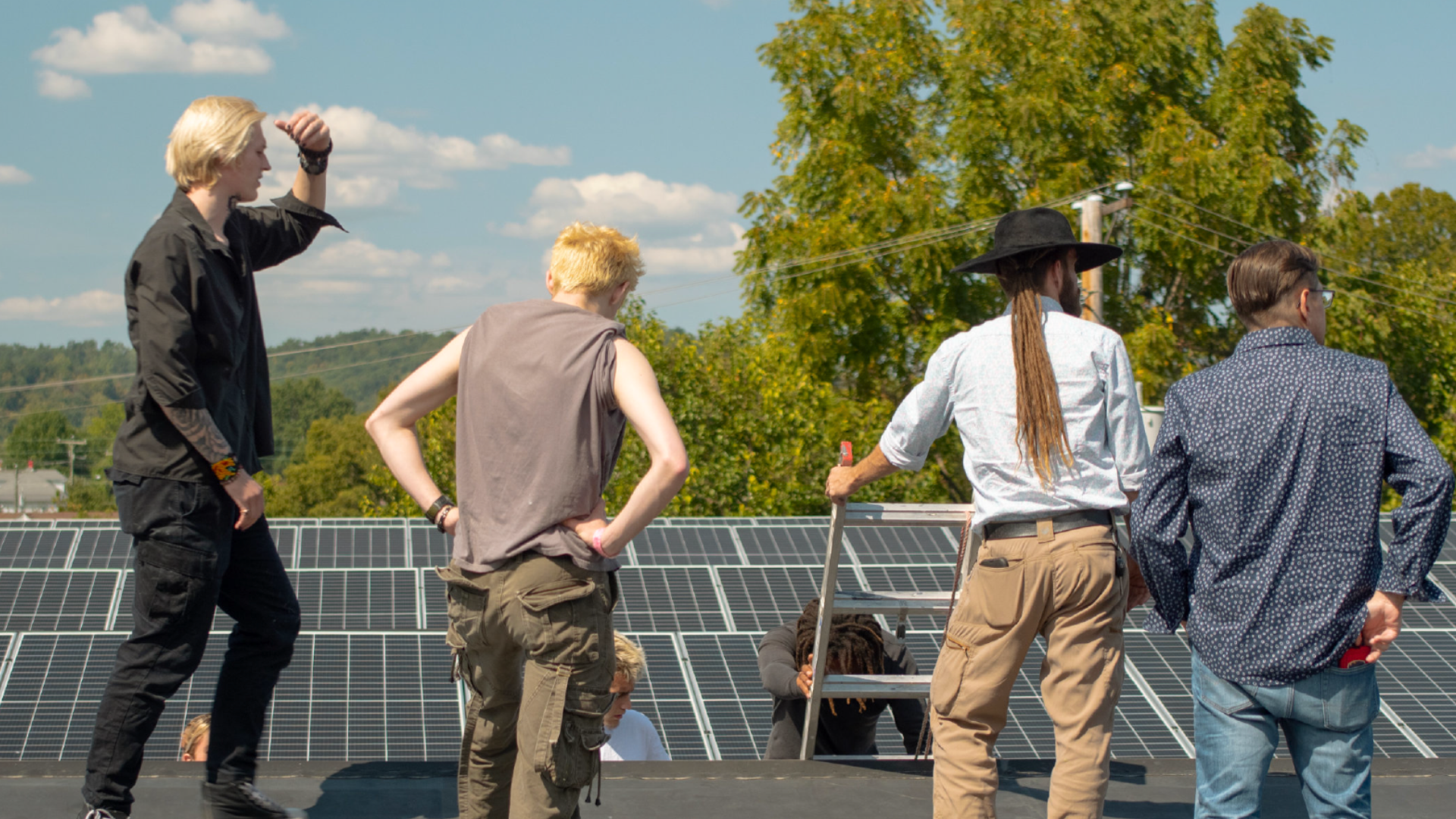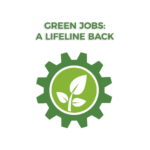
The Green Economy is one of five sectors that will drive the economic recovery, according to a recent report from Burning Glass Technologies. The report states the nation’s energy system has been steadily shifting towards renewables and adds that “ambitious climate goals and incentives are likely to speed the shift.”
“If you take a ‘glass is half full’ approach on Earth Day 2021, we should be thinking about the positive fact that many more people are focused on environmental issues and that green jobs are a central part of economic recovery and the post-COVID age.” That from Paula DiPerna, a special advisor to CDP, a nonprofit that works with its members to manage their environmental impacts. DiPerna is also a WorkingNation consultant on environmental jobs.

She adds, “If you take the ‘glass is half empty’ approach, the world is probably at least 40 years behind where it should be—not addressing major environmental issues like climate change. You could interpret that to mean that we’ve missed 40 years of jobs creation and reinvigorating our industrial economy.”
DiPerna says to help make up for lost time it’s important to focus on breakthroughs. “There’s tremendous technological advantage now, which we should apply to the problems of environmental necessity—technologies which didn’t exist 40 years ago definitely can help accelerate.”
‘Every job has the potential to be green’
“What we’re seeing, which I think is really a hopeful sign, is that nearly every job has the potential to be green,” says Karin Kimbrough, chief economist at LinkedIn.
“I’m a believer that COVID—for all of the horrors that it had in terms of the toll on people’s health, physically and mentally—it did present an opportunity to kickstart and expand the focus on what a recovery could look like. It allowed space for people to say, ‘Let’s make sure this recovery is sustainable. Let’s make sure it’s green,’” she tells WorkingNation.

Kimbrough continues, “It’s almost like this is a chance to get it right, to make this recovery really green-focused, and not in a performative way, but in a sincere way. Like it’s part of a true strategy over a longer period of time.”
The Jobs Outlook in the Environmental Sector
“Although solar installations—and energy use in general—took a major dive in the second quarter of 2020 because of the pandemic, it’s significant that solar made up the difference and then some in the rest of the year,” according to the Burning Glass report.
The report says that between 2019 and 2020, there was increased demand for solar sales representatives and solar installers. Other strong occupations include wind turbine technicians and environmental technicians. These positions do not require a bachelor’s degree.

“We’re seeing a demand for talent. And we’re definitely seeing when that talent brings a ‘green skill’ it’s a plus,” says LinkedIn’s Kimbrough. “The International Labour Organization is estimating 24 million jobs worldwide could be created, just by what we call the green economy, by 2030,” adds Kimbrough.
In a LinkedIn post, Kimbrough describes a green skill. “They are abilities or knowledge a worker can use to prevent, monitor or clean up pollution, and optimize stewardship and conservation of the natural resources that companies use to produce goods and services.”
“LinkedIn’s team met with experts, reviewed studies and hand-reviewed thousands of skills. We identified about 800 ‘core’ green skills and more than 300 green-related skills across 12 categories including pollution prevention, waste prevention, renewable energy and sustainability,” the post continues.
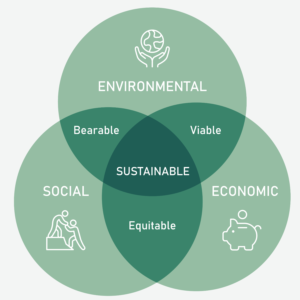
Kimbrough tells WorkingNation there is opportunity on LinkedIn Learning to increase what she calls a person’s “environmental literacy.” “There are learning courses where you can upskill yourself to know more about supply chain management, measurement of environmental impacts, creating sustainable products.”
“A lot of these things sound a little abstract, but to the extent that you can educate yourself through short skilling programs and I don’t mean programs that are eight, 10 weeks long, I’m talking about skilling that can happen in a much shorter amount of time, to be better aware and more literate around mitigation techniques for whatever field you’re in. You don’t have to change your industry to become more sustainable. You have to think about, ‘How can I bring sustainability into my industry?’”
Kimbrough continues, “Postings are calling for green skills for particular jobs. It’s not just geologists. It’s transportation engineers or customer service representatives. Green skills are being called for warehouse specialists who need to understand recycling, hazardous materials, and OSHA regulations. Quality inspectors who need to understand environmental monitoring and health and safety regulations.”
“If you are a project manager, one of the most common job titles on our platform that doesn’t require a four-year degree, you are often asked, ‘What is your environmental awareness?’ So there are so many jobs that don’t appear to be green, but have the potential to get increasingly greener.”
Greening of the Health Care Industry

As an example of an industry that might not be seen as green, Kimbrough cites health care.
“When I look at health care, what I’m capturing are lots of health centers and hospitals. Those hospitals will be hiring, not just doctors and nurses, but also people who are managing the waste, managing the heating and air conditioning systems, deliveries, who their suppliers are,” explains Kimbrough.
“So it’s capturing a lot of roles that may not be explicitly health care. At LinkedIn, when we think about jobs, we can think about the job itself, but also the sector it lives in.”
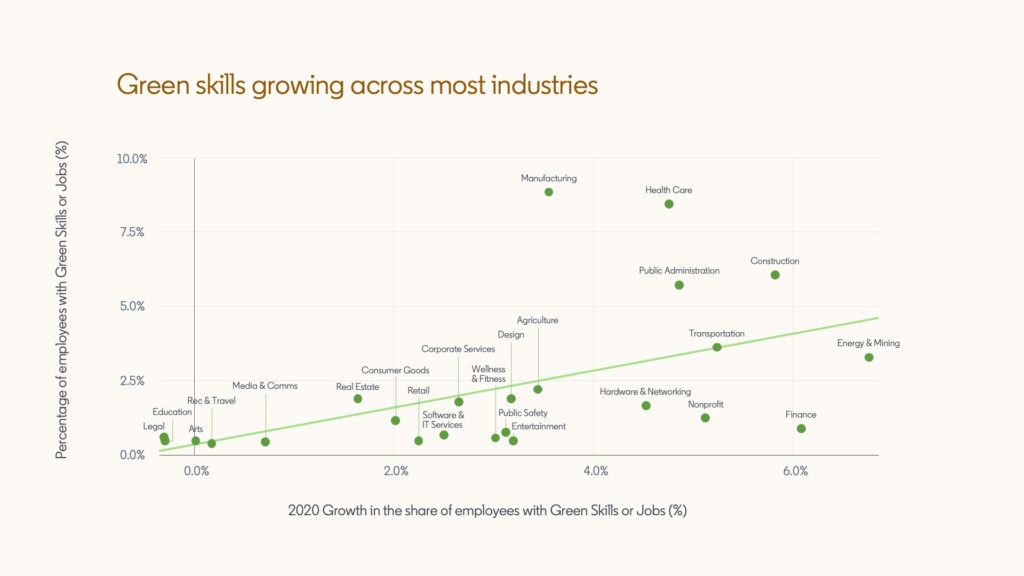
Everyone Can Be Involved
Kimbrough uses the phrase “broaden the aperture.” “I want to think about skills and jobs, not just as ‘I have a green skill because I know all about composting,’ but how about ‘I have skills and expertise in the green space because I can take any job that I do and think about how to do it with a smaller carbon footprint or how to do that job in a way that’s more sustainable in the long run.’”
“The environment is everything. It provides a subsidy that enables everything else to happen,” says DiPerna. “Everybody can be involved—from the hardware store to hard science. It’s a complete transformation that we can create.”
“The fact is if we are to address environmental problems, what does it mean? It means we have to redesign, replace, rehabilitate, reorient, rebuild, retrofit just about everything. On some level that sounds very daunting, but on another level is so exciting,” adds DiPerna.
Check Out These Learning Resources
LinkedIn Learning is unlocking sustainability-related courses through April 26.
- Sustainability Strategies – Overview of how to incorporate sustainability into business operations, responsible supply chain management, creation of sustainable products and services, and management and measurement of environmental impacts.
- Learning Design for Sustainability – Tools, resources and best practices of sustainable design for products, the built environment, and services.
- Employees’ Guide to Sustainability – Learn how individual and collective action can help address climate change, land and ocean degradation, and overconsumption.

WorkingNation is putting green jobs on the map, both literally and figuratively.
“We are working to track the nation’s first real-time research on existing and projected green jobs creation—state by state, industry by industry,” says Joan Lynch, WorkingNation’s chief content and programming officer. “Our goal is to develop a proprietary research database and interactive visual presentation that identifies both the types of jobs and relative economic implications by sector, including necessary skillsets needed for employment,” notes Lynch.
First up – Pennsylvania. Data is expected to be released in late spring.

